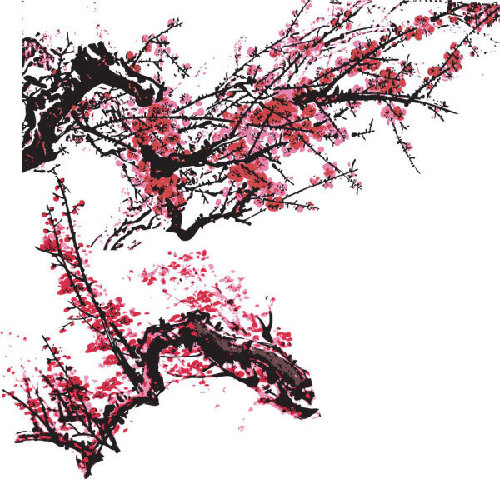
The plum blossom, flower of the Prunus mume, is a prominent icon of traditional Chinese culture and one of the most loved subjects in Chinese artwork. As one of the few species of plant that flower in the dead of winter, it is celebrated as representing the virtues of tenacity, chastity and fortitude, all key facets of the Chinese ethos.
Plum blossoms appear in ink paintings throughout China’s history, and continue to be a popular motif. Chinese American artist Zheng Faxiang has brought this legacy to a new height in the contempory art scene. Earlier this year he staged a solo exhibition of approximately 100 of his plum blossom paintings in Taipei, the third such exhibition since 2009. All were well received by local art appreciators who share cultural identity with their cousins across the strait.
For the artist the plant portrays life that thrives in adversity and sticks to its principles under all circumstances, a diminishing yet highly valued attribute in today’s increasingly materialized world.
“Plum blossom is emblematic of the Chinese spirit,” said Zheng. “It braves freezing temperatures and defies devastating snow and frost, standing out as a lone sign of vibrant life amid winter hibernation. Even when the bloom falls in the dirt, the fragrance stays. A good artwork on the theme, may it be calligraphy, poetry or painting, has the power to inspire and purge the soul.”
Zheng’s affection for the flower can be traced back to his personal experiences. Born into a destitute family and raised amid poverty and social instability, Zheng learnt at a young age to keep a stiff upper lip in the face of adversity, a propensity that has led him to his current success. He has traversed a long and rocky path in the world of art since his first ephemeral drawings in the sand along the river of his hometown in Fujian Province.
Through traditional medium of ink and brush, Zheng breaks away from the convention of leaving large swaths of unpainted space in the picture, instead applying washes to invoke an air of solitude and melancholy. He has created a style featuring vibrant colors, energetic composition and twists of Western aesthetics of perspective and scale. The result expresses a sense of sanguine euphoria.
Such unconventionality highlights, rather than downplays, the moral elements of the image by rendering it in a way that is more easily discernable to modern day audiences. For instance, in traditional plum blossom paintings the gnarled trunk and branches are painted in such a way as to suggest a dragon. Zheng Faxiang lends a surrealistic touch to their configuration to exaggerate that insinuation, giving prominence to the sinew and vigor the tree exudes. This and other features the artist demonstrates in his works win the acclaim of Guan Shanyue, one of the most revered Chinese painters of modern times, who called Zheng’s plum blossom painting “one of a kind, creative and conveying well wrought skills gained through long practice.”
In his early years Zheng attended illustrious art schools including the China Central Academy of Fine Arts and the Chinese National Academy of Arts. He began to gain a reputation for his plum blossom painting in the 1990s, and soon was regarded as a prodigy in this genre.
Now secretary general of the New York-based World Artists Association, Zheng has held solo exhibitions in 30 countries and regions around the world and published 20-plus albums. His works have been awarded honors in the U.S., Europe and China, and are highly sought after at auctions. They are also on display at such famous venues as Zhongnanhai – headquarters of China’s central government, Diaoyutai State Guesthouse, the Great Hall of the People, the Tian’anmen gate tower, the National Art Museum of China, the U.N. headquarters, Chinese embassies in the U.S. and the U.K. and Chinese consulate in New York.
Though best known for his flora, Zheng is actually a very versatile artist and has also made a mark producing portraits, landscapes and animal paintings as well as seal carving and calligraphy. Painting and brush calligraphy are traditionally known as agnate arts, as both require perceptive and accurate application of each stroke together with thoughtful arrangement of the parts as the whole. Aptitude at one hence rebounds to the other. This is evident in Zheng’s creations. His calligraphy is imbued with graphic elaboration, while his painting carries the grace of pencraft.
As ink painting and calligraphy are among the most shining representatives of the Chinese legacy, Zheng Faxiang feels dual obligations to push them to new artistic heights through personal efforts and spread them to people in other cultures. He has been traveling around the world to advocate Chinese culture and has set up an educational foundation in his hometown Changle City in Fujian Province. He hopes that, like all things enlightening that have been passed down through human civilization, Chinese values and virtue as embodied by plum blossom can be appreciated by succeeding generations, whether native to China or spread out across the globe, and that this will have positive influence on their lives.
Source: China Today
